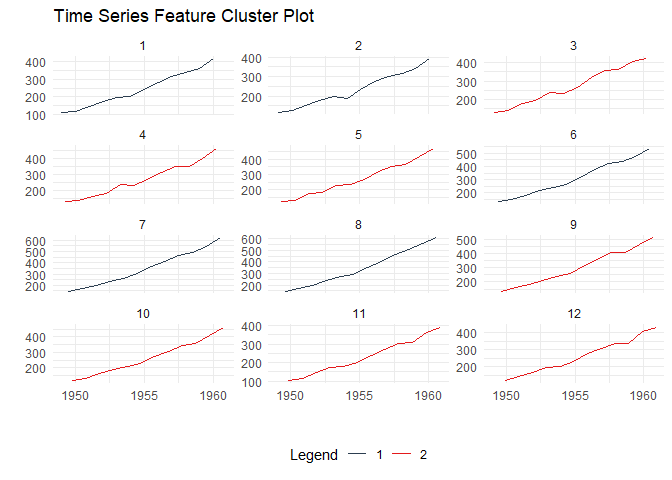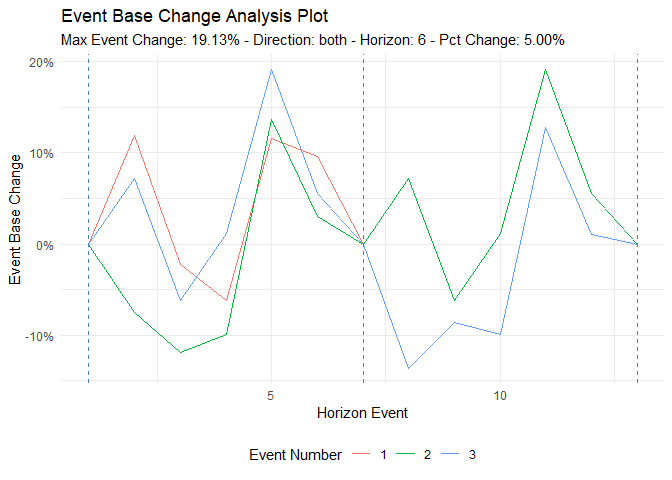

The goal of healthyR.ts is to provide a consistent verb
framework for performing time series analysis and forecasting on both
administrative and clinical hospital data.
You can install the released version of healthyR.ts from CRAN with:
install.packages("healthyR.ts")And the development version from GitHub with:
# install.packages("devtools")
devtools::install_github("spsanderson/healthyR.ts")This is a basic example which shows you how to generate random walk data.
library(healthyR.ts)
library(ggplot2)
df <- ts_random_walk()
head(df)
#> # A tibble: 6 × 4
#> run x y cum_y
#> <dbl> <dbl> <dbl> <dbl>
#> 1 1 1 0.0521 1052.
#> 2 1 2 0.000486 1053.
#> 3 1 3 0.0567 1112.
#> 4 1 4 0.125 1252.
#> 5 1 5 0.0825 1355.
#> 6 1 6 0.00340 1360.Now that the data has been generated, lets take a look at it.
df %>%
ggplot(
mapping = aes(
x = x
, y = cum_y
, color = factor(run)
, group = factor(run)
)
) +
geom_line(alpha = 0.8) +
ts_random_walk_ggplot_layers(df)
That is still pretty noisy, so lets see this in a different way. Lets clear this up a bit to make it easier to see the full range of the possible volatility of the random walks.
library(dplyr)
library(ggplot2)
df %>%
group_by(x) %>%
summarise(
min_y = min(cum_y),
max_y = max(cum_y)
) %>%
ggplot(
aes(x = x)
) +
geom_line(aes(y = max_y), color = "steelblue") +
geom_line(aes(y = min_y), color = "firebrick") +
geom_ribbon(aes(ymin = min_y, ymax = max_y), alpha = 0.2) +
ts_random_walk_ggplot_layers(df)
This package comes with a wide variety of functions from Data
Generators to Statistics functions. The function
ts_random_walk() in the above example is a Data
Generator.
Let’s take a look at a plotting function.
data_tbl <- data.frame(
date_col = seq.Date(
from = as.Date("2020-01-01"),
to = as.Date("2022-06-01"),
length.out = 365*2 + 180
),
value = rnorm(365*2+180, mean = 100)
)
ts_calendar_heatmap_plot(
.data = data_tbl
, .date_col = date_col
, .value_col = value
, .interactive = FALSE
)
Time Series Clustering via Features:
data_tbl <- ts_to_tbl(AirPassengers) %>%
mutate(group_id = rep(1:12, 12))
output <- ts_feature_cluster(
.data = data_tbl,
.date_col = date_col,
.value_col = value,
group_id,
.features = c("acf_features","entropy"),
.scale = TRUE,
.prefix = "ts_",
.centers = 3
)
ts_feature_cluster_plot(
.data = output,
.date_col = date_col,
.value_col = value,
.center = 2,
group_id
)
#> $plot
#> $plot$static_plot
#>
#> $plot$plotly_plot
#>
#>
#> $data
#> $data$original_data
#> # A tibble: 144 × 4
#> index date_col value group_id
#> <yearmon> <date> <dbl> <int>
#> 1 Jan 1949 1949-01-01 112 1
#> 2 Feb 1949 1949-02-01 118 2
#> 3 Mar 1949 1949-03-01 132 3
#> 4 Apr 1949 1949-04-01 129 4
#> 5 May 1949 1949-05-01 121 5
#> 6 Jun 1949 1949-06-01 135 6
#> 7 Jul 1949 1949-07-01 148 7
#> 8 Aug 1949 1949-08-01 148 8
#> 9 Sep 1949 1949-09-01 136 9
#> 10 Oct 1949 1949-10-01 119 10
#> # ℹ 134 more rows
#>
#> $data$kmm_data_tbl
#> # A tibble: 3 × 3
#> centers k_means glance
#> <int> <list> <list>
#> 1 1 <kmeans> <tibble [1 × 4]>
#> 2 2 <kmeans> <tibble [1 × 4]>
#> 3 3 <kmeans> <tibble [1 × 4]>
#>
#> $data$user_item_tbl
#> # A tibble: 12 × 8
#> group_id ts_x_acf1 ts_x_acf10 ts_diff1_acf1 ts_diff1_acf10 ts_diff2_acf1
#> <int> <dbl> <dbl> <dbl> <dbl> <dbl>
#> 1 1 0.741 1.55 -0.0995 0.474 -0.182
#> 2 2 0.730 1.50 -0.0155 0.654 -0.147
#> 3 3 0.766 1.62 -0.471 0.562 -0.620
#> 4 4 0.715 1.46 -0.253 0.457 -0.555
#> 5 5 0.730 1.48 -0.372 0.417 -0.649
#> 6 6 0.751 1.61 0.122 0.646 0.0506
#> 7 7 0.745 1.58 0.260 0.236 -0.303
#> 8 8 0.761 1.60 0.319 0.419 -0.319
#> 9 9 0.747 1.59 -0.235 0.191 -0.650
#> 10 10 0.732 1.50 -0.0371 0.269 -0.510
#> 11 11 0.746 1.54 -0.310 0.357 -0.556
#> 12 12 0.735 1.51 -0.360 0.294 -0.601
#> # ℹ 2 more variables: ts_seas_acf1 <dbl>, ts_entropy <dbl>
#>
#> $data$cluster_tbl
#> # A tibble: 12 × 9
#> cluster group_id ts_x_acf1 ts_x_acf10 ts_diff1_acf1 ts_diff1_acf10
#> <int> <int> <dbl> <dbl> <dbl> <dbl>
#> 1 1 1 0.741 1.55 -0.0995 0.474
#> 2 1 2 0.730 1.50 -0.0155 0.654
#> 3 2 3 0.766 1.62 -0.471 0.562
#> 4 2 4 0.715 1.46 -0.253 0.457
#> 5 2 5 0.730 1.48 -0.372 0.417
#> 6 1 6 0.751 1.61 0.122 0.646
#> 7 1 7 0.745 1.58 0.260 0.236
#> 8 1 8 0.761 1.60 0.319 0.419
#> 9 2 9 0.747 1.59 -0.235 0.191
#> 10 2 10 0.732 1.50 -0.0371 0.269
#> 11 2 11 0.746 1.54 -0.310 0.357
#> 12 2 12 0.735 1.51 -0.360 0.294
#> # ℹ 3 more variables: ts_diff2_acf1 <dbl>, ts_seas_acf1 <dbl>, ts_entropy <dbl>
#>
#>
#> $kmeans_object
#> $kmeans_object[[1]]
#> K-means clustering with 2 clusters of sizes 5, 7
#>
#> Cluster means:
#> ts_x_acf1 ts_x_acf10 ts_diff1_acf1 ts_diff1_acf10 ts_diff2_acf1 ts_seas_acf1
#> 1 0.7456468 1.568532 0.1172685 0.4858013 -0.1799728 0.2876449
#> 2 0.7387865 1.528308 -0.2909349 0.3638392 -0.5916245 0.2930543
#> ts_entropy
#> 1 0.4918321
#> 2 0.6438176
#>
#> Clustering vector:
#> [1] 1 1 2 2 2 1 1 1 2 2 2 2
#>
#> Within cluster sum of squares by cluster:
#> [1] 0.3704304 0.3660630
#> (between_SS / total_SS = 59.8 %)
#>
#> Available components:
#>
#> [1] "cluster" "centers" "totss" "withinss" "tot.withinss"
#> [6] "betweenss" "size" "iter" "ifault"Time to/from Event Analysis
library(dplyr)
df <- ts_to_tbl(AirPassengers) %>% select(-index)
ts_time_event_analysis_tbl(
.data = df,
.horizon = 6,
.date_col = date_col,
.value_col = value,
.direction = "both"
) %>%
ts_event_analysis_plot()
ts_time_event_analysis_tbl(
.data = df,
.horizon = 6,
.date_col = date_col,
.value_col = value,
.direction = "both"
) %>%
ts_event_analysis_plot(.plot_type = "individual")
ARIMA Simulators
output <- ts_arima_simulator()
output$plots$static_plot
Automatic Workflows which can be thought of as Boiler Plate Time Series modeling. This is in it’s infancy in this package.
| Auto Workflows | Boilerplate Workflow |
|---|---|
| ts_auto_arima() | Boilerplate Workflow |
| ts_auto_arima_xgboost() | Boilerplate Workflow |
| ts_auto_croston() | Boilerplate Workflow |
| ts_auto_exp_smoothing() | Boilerplate Workflow |
| ts_auto_glmnet() | Boilerplate Workflow |
| ts_auto_lm() | Boilerplate Workflow |
| ts_auto_mars() | Boilerplate Workflow |
| ts_auto_nnetar() | Boilerplate Workflow |
| ts_auto_prophet_boost() | Boilerplate Workflow |
| ts_auto_prophet_reg() | Boilerplate Workflow |
| ts_auto_smooth_es() | Boilerplate Workflow |
| ts_auto_svm_poly() | Boilerplate Workflow |
| ts_auto_svm_rbf() | Boilerplate Workflow |
| ts_auto_theta() | Boilerplate Workflow |
| ts_auto_xgboost() | Boilerplate Workflow |
This is just a start of what is in this package!